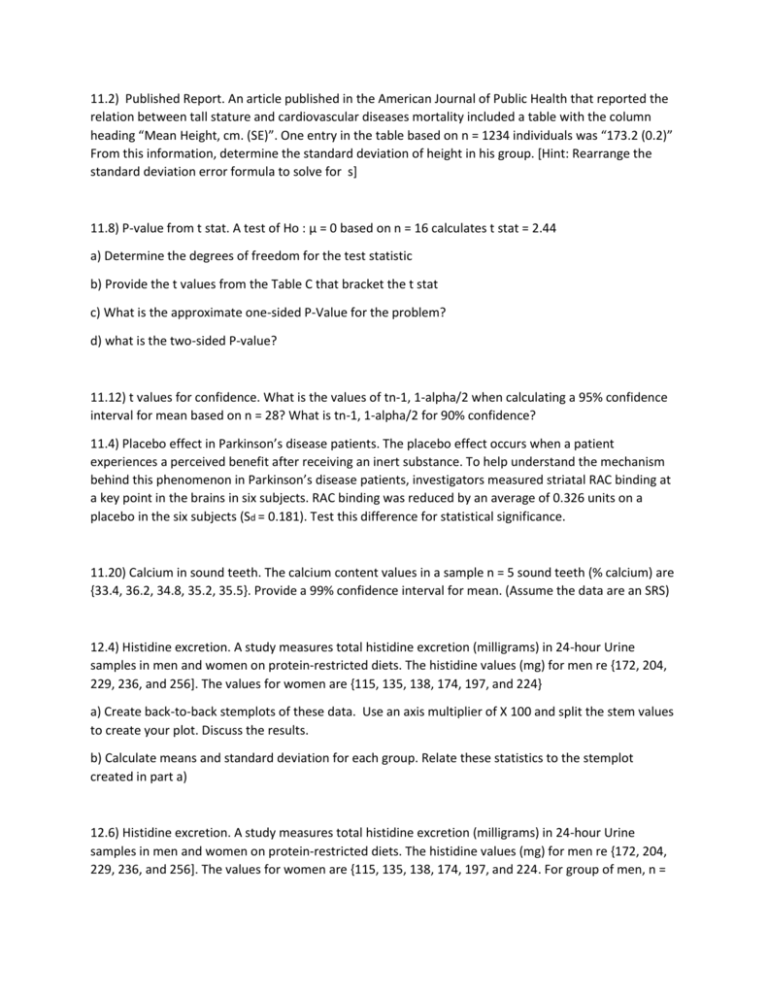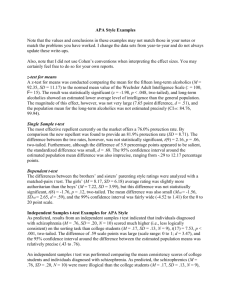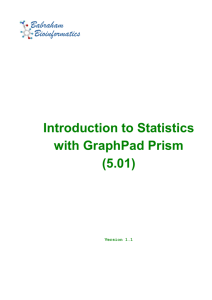Unpaired t test results
advertisement

11.2) Published Report. An article published in the American Journal of Public Health that reported the
relation between tall stature and cardiovascular diseases mortality included a table with the column
heading “Mean Height, cm. (SE)”. One entry in the table based on n = 1234 individuals was “173.2 (0.2)”
From this information, determine the standard deviation of height in his group. [Hint: Rearrange the
standard deviation error formula to solve for s]
11.8) P-value from t stat. A test of Ho : μ = 0 based on n = 16 calculates t stat = 2.44
a) Determine the degrees of freedom for the test statistic
b) Provide the t values from the Table C that bracket the t stat
c) What is the approximate one-sided P-Value for the problem?
d) what is the two-sided P-value?
11.12) t values for confidence. What is the values of tn-1, 1-alpha/2 when calculating a 95% confidence
interval for mean based on n = 28? What is tn-1, 1-alpha/2 for 90% confidence?
11.4) Placebo effect in Parkinson’s disease patients. The placebo effect occurs when a patient
experiences a perceived benefit after receiving an inert substance. To help understand the mechanism
behind this phenomenon in Parkinson’s disease patients, investigators measured striatal RAC binding at
a key point in the brains in six subjects. RAC binding was reduced by an average of 0.326 units on a
placebo in the six subjects (Sd = 0.181). Test this difference for statistical significance.
11.20) Calcium in sound teeth. The calcium content values in a sample n = 5 sound teeth (% calcium) are
{33.4, 36.2, 34.8, 35.2, 35.5}. Provide a 99% confidence interval for mean. (Assume the data are an SRS)
12.4) Histidine excretion. A study measures total histidine excretion (milligrams) in 24-hour Urine
samples in men and women on protein-restricted diets. The histidine values (mg) for men re {172, 204,
229, 236, and 256]. The values for women are {115, 135, 138, 174, 197, and 224}
a) Create back-to-back stemplots of these data. Use an axis multiplier of X 100 and split the stem values
to create your plot. Discuss the results.
b) Calculate means and standard deviation for each group. Relate these statistics to the stemplot
created in part a)
12.6) Histidine excretion. A study measures total histidine excretion (milligrams) in 24-hour Urine
samples in men and women on protein-restricted diets. The histidine values (mg) for men re {172, 204,
229, 236, and 256]. The values for women are {115, 135, 138, 174, 197, and 224. For group of men, n =
5, mean = 219.40 and standard deviation = 32.370. For group of women, n = 6, mean = 163.83 and
standard deviation = 41.730
a) Calculate the standard error of the mean difference without assuming equal variances
b) a computer program calculates dfwelch ≈ 9 for these data. Based on this df, calculate a 95%
confidence interval for Mean1-mean2
c) Calculate two-sided P-value for testing H0:mean1 = mean2
Unpaired t test results
P value and statistical significance:
The two-tailed P value equals 0.0383
By conventional criteria, this difference is considered to be statistically significant.
Confidence interval:
The mean of Men minus Women equals 55.57000
95% confidence interval of this difference: From 3.71360 to 107.42640
Intermediate values used in calculations:
t = 2.4242
df = 9
standard error of difference = 22.923
Learn more:
GraphPad's web site includes portions of the manual for GraphPad Prism that can help you learn
statistics. First, review the meaning of P values and confidence intervals. Then learn how to
interpret results from an unpaired or paired t test. These links include GraphPad's popular analysis
checklists.
Review your data:
Group
Men
Women
Mean 219.40000 163.83000
SD 32.37000
41.73000
SEM 14.47630
17.03620
N
5
6
12.16) Cytomegalovirus and coronary stenosis. Coronary stenosis (narrowing of the attery supply to the
heart muscle) is a direct cause of hear disease. A theory suggests that chronic cytomegalovirus (CMV)
infection narrows coronary vessels and leads to coronary heart disease. To test this theory, 75 patients
undergoing angioplasty were followed for 6 months following their procedure. The 49 patients who
were seropositive for CMV experienced an average luminal diameter reduction of 1.24mm (S1 =
0.83mm). In contrast, the 26 patients who seronegative for CMV experienced an average luminal
reduction of 0.68 (S2 = 0.69) Test whether this mean difference in luminal reduction in significant. Show
all hypothesis-testing steps. Do data support the hypothesis that chronic CMV virus infection plays a role
in coronary luminal reduction? Yes values are significantly difference
Unpaired t test results
P value and statistical significance:
The two-tailed P value equals 0.0068
By conventional criteria, this difference is considered to be very statistically significant.
Confidence interval:
The mean of seronegative minus seropositive equals -0.5600
95% confidence interval of this difference: From -0.9621 to -0.1579
Intermediate values used in calculations:
t = 2.7633
df = 99
standard error of difference = 0.203
Learn more:
GraphPad's web site includes portions of the manual for GraphPad Prism that can help you learn
statistics. First, review the meaning of P values and confidence intervals. Then learn how to
interpret results from an unpaired or paired t test. These links include GraphPad's popular analysis
checklists.
Review your data:
Group seronegative
seropositive
Mean
0.6800
1.2400
SD
0.8300
0.9100
SEM
0.1628
0.1051
26
75
N
16.6) AIDS-related risk factor. Consider a survey in which 70 of 2,673 individuals (6.4% reported having
two or more sexual partners in the prior 12 months. This study was completed in the arly 1990s.
Suppose an earlier study (completed in the 1970s) suggested that the prevalence of this attribute in the
population was 7.5%. Recalculate the P-value here using the continuity-corrected Z-statistic. Is the Pvalue from the continuity-corrected z-statistic larger or smaller than that from the non-correted zstatistic?
16.8) Consider a problem in which seven of eight patients expressed a preference for medical procedure
A compared to medical procedure B. A Normal approximation test was precluded because of the small
sample size. You tested the hypothesis of equal preference for medical procedure A and medical
procedure B with Fisher’s procedure. What is therefore the Mid-P P-Value for this problem?
Test of the hypothesis that two correlation coefficients obtained from independent samples are
equal. The result is a z-score which may be compared in a 1-tailed or 2-tailed fashion to the unit
normal distribution. By convention, values greater than |1.96| are considered significant if a 2tailed test is performed.
How it's done
First, each correlation coefficient is converted into a z-score using Fisher's r-to-z transformation.
Then, making use of the sample size employed to obtain each coefficient, these z-scores are
compared using formula 2.8.5 from Cohen and Cohen (1983, p. 54).
10.14) BRCA1 mutations in familial breast cancer cases. Of 169 women haaving breast cancer and a
familial risk factor, 27 had an inherited BRCA1 mutation. Based on this information, estimate the
prevalence of BRCA1 mutation in women with familial breast cancer. Include a 95% confidence interval
in the prevalence.
16.18) Leukemia gender preference. A simple random sample of 262 leukemia cases consisted of 150
males and 112 females. Does this provide evidence of a gender preference for the disease? [Observed
proportion, male = 150 /(150 + 112) = 0.5725. Test Ho: p = 0.5]
If yes if you confidence interval is .05 Ho means you are 95% sure that the Ho the null is incorrect it is 5%
correct.
16.24) Binge drinking in US colleges. Alcohol abuse is a serious problem on college campuses. A
nationwide survey of students at 4-year colleges found that 3314 of the 17,096 student respondents
met the criterion for being a “frequent binge drinker” (five or more drinks in a row three or more times
in the past 2-week period) Assume data represent an SRS of 4-year colleges.
a) Calculate the observed prevalence of frequent binge drinking
b) Calculate a 95% confidence interval for p
c) Data were self-reported. In addition, the response rate was 69%. How might these facts influence the
estimates?
a) observed = 3314
b.
Unpaired t test results
P value and statistical significance:
The two-tailed P value is less than 0.0001
By conventional criteria, this difference is considered to be extremely statistically significant.
Confidence interval:
The mean of early minus late equals -10468.00000000
95% confidence interval of this difference: From -10524.77251716 to -10411.22748284
Intermediate values used in calculations:
t = 362.2645
df = 34190
standard error of difference = 28.896
Learn more:
GraphPad's web site includes portions of the manual for GraphPad Prism that can help you learn
statistics. First, review the meaning of P values and confidence intervals. Then learn how to
interpret results from an unpaired or paired t test. These links include GraphPad's popular analysis
checklists.
Review your data:
Group
early
late
Mean 3314.00000000 13782.00000000
SD 2671.59265300 2671.59265300
SEM
N
20.43256955
17096
20.43256955
17096
c. Not a random sample if only 69% also only at one school so cannot generalize these results
17.2) Hypothetical situation. Consider a fictitious study based in two populations. Twenty-five percent of
the individuals in both populations have a particular risk factor (P1 = p2 = 0.25). We randomly selected
3750 subjects from each population (1=n2=3750).
a) these are large samples, so the sampling distribution of p1-2 will be approximately Normal. What are
the mean and standard deviation of the sampling distribution?
b) What percent of repeate independent SRS’s of the given sizes will have prevalence difference that fall
in the range -0.02 to 0.02?
18
17.6) Medicine d’observation. Pierre-charles Alexandre Louis (17871872) is often referred to as the
“father of clinical statistics” . In 1837, he wrote “ I conceive that without the aid of statistics nothing like
real medical science is possible”. In his most famous study, Louis evaluated bloodletting as a treatment
for pneumonia. At the time, bloodletting was an extremely popular for of therapy Two forms were
practiced: by lancet (cutting vein) and placement of leeches on specific body parts. Louis called into
question the effectiveness of these therapies by carefully monitoring and recording outcomes in
treatment groups. In one analysis, he compared patients who received early bloodletting (treatment
group0 to those who received late treatment (control group) . He found that 18 of 41 patients in the
early treatment group died. In contrast, 9 of 36 control patients died.
a) Calculate the mortality risk difference in the group
b) Test the difference for significance. Report a two-tailed P-value for the test. Interpret the results.
Unpaired t test results
P value and statistical significance:
The two-tailed P value is less than 0.0001
By conventional criteria, this difference is considered to be extremely statistically significant.
Confidence interval:
The mean of early minus late equals 9.000
95% confidence interval of this difference: From 5.535 to 12.465
Intermediate values used in calculations:
t = 5.1877
df = 65
standard error of difference = 1.735
Learn more:
GraphPad's web site includes portions of the manual for GraphPad Prism that can help you learn
statistics. First, review the meaning of P values and confidence intervals. Then learn how to
interpret results from an unpaired or paired t test. These links include GraphPad's popular analysis
checklists.
Review your data:
Group early
late
Mean 18.000 9.000
SD
7.500 6.700
SEM
1.347 1.117
N
31
36
17.14) Telephone survey contact rates. Telephone surveys typically have high rates of nonresponse.
This can cause bias when the variables being studied are associated with factors that determine the
response rate. For mail and home delivery surveys, it is know that advanced-warning letters letting
participants know that a survey is on its way increases overall response. A study investigated the utility
of leaving messages on answering machines as a means of encouraging participation in telephone
surveys. A message was left or not left random when answering machine picked up the first call of the
telephone survey. Here is the data;
Message; Contacted = 200, not contacted = 91, Households = 291
No Message; Contacted = 58, not contacted = 42, Households 100
17.18) The Scandinavian simvastatin survival study (4S) was a randomized clinical trial designed to
evaluate the effects of cholesterol-lowering agent simvastatin in patients with coronary heart disease.
Over 5.4 years follow-up, the treatment group consisting of 2221 individuals experienced 111 fatal heart
attacks. The placebo group of 2223 individuals experienced 189 such events. 4S study introduced in
exercise 17.17 also tallied deaths due to any cause. The treatment group experienced 182 deaths (n1 =
2221) and the control group experienced 256 deaths (n2 = 2223). Compare the mortality experience in
the two groups in the form of relative risk and 95% confidence interval.
P value and statistical significance:
The two-tailed P value is less than 0.0001
By conventional criteria, this difference is considered to be extremely statistically significant.
Confidence interval:
The mean of Placebo minus treatment equals 74.000
95% confidence interval of this difference: From 67.013 to 80.987
Intermediate values used in calculations:
t = 20.8084
df = 4442
standard error of difference = 3.556
Learn more:
GraphPad's web site includes portions of the manual for GraphPad Prism that can help you learn
statistics. First, review the meaning of P values and confidence intervals. Then learn how to
interpret results from an unpaired or paired t test. These links include GraphPad's popular analysis
checklists.
Review your data:
Group Placebo
treatment
Mean
256.000
182.000
SD
15.000
167.000
SEM
0.318
3.544
N
2223
2221
17.20) Drug testing athletes. The supreme court of the united states ruled in 2002 that schools could
require random drug testing of students who participate in after-school activities. At that time, it was
not known whether random drug testing reduced use of illicit drugs. To address this question,
researchers at the Oregon Health and Science University completed a study in which student athletes at
Wahtonka High School were subject to random drug testing, while student athletes at Warrenton High
School were not subject to random testing. Five of the 95 students athletes at the Wahtonka School
were positive for illicit drugs, while 12 of 62 student athletes at warrenton High School were positive.
Compare the experience of these two schools with methods introduced in this chapter. The question is
intentionally left open to students the opportunity to analyze the data in ways they see fit. More than
one correct response is possible.
T test
P value and statistical significance:
The two-tailed P value is less than 0.0001
By conventional criteria, this difference is considered to be extremely statistically significant.
Confidence interval:
The mean of wahtonka minus warrington equals -7.0000
95% confidence interval of this difference: From -9.2612 to -4.7388
Intermediate values used in calculations:
t = 6.1152
df = 155
standard error of difference = 1.145
Learn more:
GraphPad's web site includes portions of the manual for GraphPad Prism that can help you learn
statistics. First, review the meaning of P values and confidence intervals. Then learn how to
interpret results from an unpaired or paired t test. These links include GraphPad's popular analysis
checklists.
Review your data:
Group wahtonka
warrington
Mean
5.0000
12.0000
SD
4.5000
9.6800
SEM
0.4617
1.2294
95
62
N
12.22) Calcium supplementation and blood pressure, hypothesis test.
a) Calculate summary statistics for the group described in Exercise No infor here?










